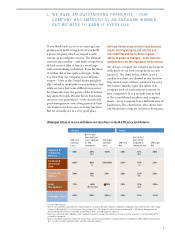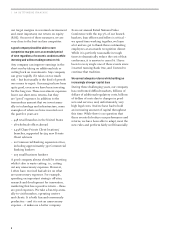JP Morgan Chase 2014 Annual Report Download - page 19
Download and view the complete annual report
Please find page 19 of the 2014 JP Morgan Chase annual report below. You can navigate through the pages in the report by either clicking on the pages listed below, or by using the keyword search tool below to find specific information within the annual report.-
 1
1 -
 2
2 -
 3
3 -
 4
4 -
 5
5 -
 6
6 -
 7
7 -
 8
8 -
 9
9 -
 10
10 -
 11
11 -
 12
12 -
 13
13 -
 14
14 -
 15
15 -
 16
16 -
 17
17 -
 18
18 -
 19
19 -
 20
20 -
 21
21 -
 22
22 -
 23
23 -
 24
24 -
 25
25 -
 26
26 -
 27
27 -
 28
28 -
 29
29 -
 30
30 -
 31
31 -
 32
32 -
 33
33 -
 34
34 -
 35
35 -
 36
36 -
 37
37 -
 38
38 -
 39
39 -
 40
40 -
 41
41 -
 42
42 -
 43
43 -
 44
44 -
 45
45 -
 46
46 -
 47
47 -
 48
48 -
 49
49 -
 50
50 -
 51
51 -
 52
52 -
 53
53 -
 54
54 -
 55
55 -
 56
56 -
 57
57 -
 58
58 -
 59
59 -
 60
60 -
 61
61 -
 62
62 -
 63
63 -
 64
64 -
 65
65 -
 66
66 -
 67
67 -
 68
68 -
 69
69 -
 70
70 -
 71
71 -
 72
72 -
 73
73 -
 74
74 -
 75
75 -
 76
76 -
 77
77 -
 78
78 -
 79
79 -
 80
80 -
 81
81 -
 82
82 -
 83
83 -
 84
84 -
 85
85 -
 86
86 -
 87
87 -
 88
88 -
 89
89 -
 90
90 -
 91
91 -
 92
92 -
 93
93 -
 94
94 -
 95
95 -
 96
96 -
 97
97 -
 98
98 -
 99
99 -
 100
100 -
 101
101 -
 102
102 -
 103
103 -
 104
104 -
 105
105 -
 106
106 -
 107
107 -
 108
108 -
 109
109 -
 110
110 -
 111
111 -
 112
112 -
 113
113 -
 114
114 -
 115
115 -
 116
116 -
 117
117 -
 118
118 -
 119
119 -
 120
120 -
 121
121 -
 122
122 -
 123
123 -
 124
124 -
 125
125 -
 126
126 -
 127
127 -
 128
128 -
 129
129 -
 130
130 -
 131
131 -
 132
132 -
 133
133 -
 134
134 -
 135
135 -
 136
136 -
 137
137 -
 138
138 -
 139
139 -
 140
140 -
 141
141 -
 142
142 -
 143
143 -
 144
144 -
 145
145 -
 146
146 -
 147
147 -
 148
148 -
 149
149 -
 150
150 -
 151
151 -
 152
152 -
 153
153 -
 154
154 -
 155
155 -
 156
156 -
 157
157 -
 158
158 -
 159
159 -
 160
160 -
 161
161 -
 162
162 -
 163
163 -
 164
164 -
 165
165 -
 166
166 -
 167
167 -
 168
168 -
 169
169 -
 170
170 -
 171
171 -
 172
172 -
 173
173 -
 174
174 -
 175
175 -
 176
176 -
 177
177 -
 178
178 -
 179
179 -
 180
180 -
 181
181 -
 182
182 -
 183
183 -
 184
184 -
 185
185 -
 186
186 -
 187
187 -
 188
188 -
 189
189 -
 190
190 -
 191
191 -
 192
192 -
 193
193 -
 194
194 -
 195
195 -
 196
196 -
 197
197 -
 198
198 -
 199
199 -
 200
200 -
 201
201 -
 202
202 -
 203
203 -
 204
204 -
 205
205 -
 206
206 -
 207
207 -
 208
208 -
 209
209 -
 210
210 -
 211
211 -
 212
212 -
 213
213 -
 214
214 -
 215
215 -
 216
216 -
 217
217 -
 218
218 -
 219
219 -
 220
220 -
 221
221 -
 222
222 -
 223
223 -
 224
224 -
 225
225 -
 226
226 -
 227
227 -
 228
228 -
 229
229 -
 230
230 -
 231
231 -
 232
232 -
 233
233 -
 234
234 -
 235
235 -
 236
236 -
 237
237 -
 238
238 -
 239
239 -
 240
240 -
 241
241 -
 242
242 -
 243
243 -
 244
244 -
 245
245 -
 246
246 -
 247
247 -
 248
248 -
 249
249 -
 250
250 -
 251
251 -
 252
252 -
 253
253 -
 254
254 -
 255
255 -
 256
256 -
 257
257 -
 258
258 -
 259
259 -
 260
260 -
 261
261 -
 262
262 -
 263
263 -
 264
264 -
 265
265 -
 266
266 -
 267
267 -
 268
268 -
 269
269 -
 270
270 -
 271
271 -
 272
272 -
 273
273 -
 274
274 -
 275
275 -
 276
276 -
 277
277 -
 278
278 -
 279
279 -
 280
280 -
 281
281 -
 282
282 -
 283
283 -
 284
284 -
 285
285 -
 286
286 -
 287
287 -
 288
288 -
 289
289 -
 290
290 -
 291
291 -
 292
292 -
 293
293 -
 294
294 -
 295
295 -
 296
296 -
 297
297 -
 298
298 -
 299
299 -
 300
300 -
 301
301 -
 302
302 -
 303
303 -
 304
304 -
 305
305 -
 306
306 -
 307
307 -
 308
308 -
 309
309 -
 310
310 -
 311
311 -
 312
312 -
 313
313 -
 314
314 -
 315
315 -
 316
316 -
 317
317 -
 318
318 -
 319
319 -
 320
320
 |
 |

1717
II. BUILT FOR THE LONG TERM
To make sure the test is severe enough, the
Fed essentially built into every bank’s results
some of the insucient and poor decisions
that some banks made during the crisis.
While I don’t explicitly know, I believe that
the Fed makes the following assumptions:
• The stress test essentially assumes that
certain models don’t work properly, partic-
ularly in credit (this clearly happened with
mortgages in 2009).
• The stress test assumes all of the negatives
of market moves but none of the positives.
• The stress test assumes that all banks’ risk-
weighted assets would grow fairly signifi-
cantly. (The Fed wants to make sure that
a bank can continue to lend into a crisis
and still pass the test.) This could clearly
happen to any one bank though it couldn’t
happen to all banks at the same time.
• The stress test does not allow a reduction
for stock buybacks and dividends. Again,
many banks did not do this until late in
the last crisis.
I believe the Fed is appropriately conserva-
tively measuring the above-mentioned aspects
and wants to make sure that each and every
bank has adequate capital in a crisis without
having to rely on good management decisions,
perfect models and rapid responses.
We believe that we would perform far better
under the Fed’s stress scenario than the Fed’s
stress test implies. Let me be perfectly clear
– I support the Fed’s stress test, and we at
JPMorgan Chase think that it is important
that the Fed stress test each bank the way it
does. But it also is important for our share-
holders to understand the dierence between
the Fed’s stress test and what we think actu-
ally would happen. Here are a few examples
of where we are fairly sure we would do
better than the stress test would imply:
• We would be far more aggressive on
cutting expenses, particularly compensa-
tion, than the stress test allows.
• We would quickly cut our dividend and
stock buyback programs to conserve
capital. In fact, we reduced our dividend
dramatically in the first quarter of 2009
and stopped all stock buybacks in the first
quarter of 2008.
• We would not let our balance sheet grow
quickly. And if we made an acquisition,
we would make sure we were properly
capitalized for it. When we bought Wash-
ington Mutual (WaMu) in September of
2008, we immediately raised $11.5 billion
in common equity to protect our capital
position. There is no way we would make
an acquisition that would leave us in a
precarious capital position.
• And last, our trading losses would unlikely
be $20 billion as the stress test shows. The
stress test assumes that dramatic market
moves all take place on one day and that
there is very little recovery of values. In
the real world, prices drop over time,
and the volatility of prices causes bid/ask
spreads to widen – which helps market-
makers. In a real-world example, in the six
months after the Lehman Brothers crisis,
J.P. Morgan’s actual trading results were
$4 billion of losses – a significant portion
of which related to the Bear Stearns acqui-
sition – which would not be repeated. We
also believe that our trading exposures are
much more conservative today than they
were during the crisis.
Finally, and this should give our shareholders
a strong measure of comfort: During the
actual financial crisis of 2008 and 2009, we
never lost money in any quarter.
We hope that, over time, capital planning
becomes more predictable. We do not believe
that banks are trying to “game” the system.
What we are trying to do is understand the
regulatory goals and objectives so we can
properly embed them in our decision-making
process. It is critical for the banking system
that the treatment of capital is coherent and
